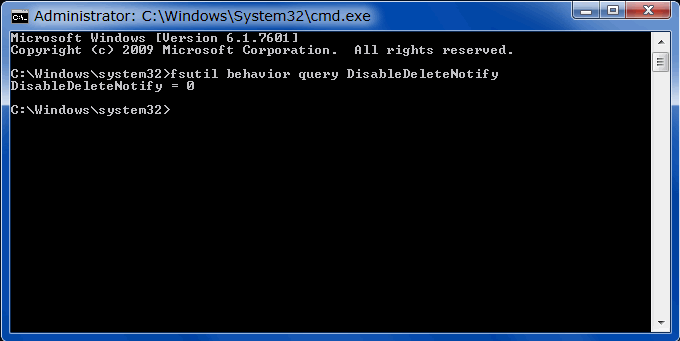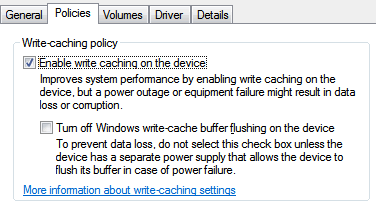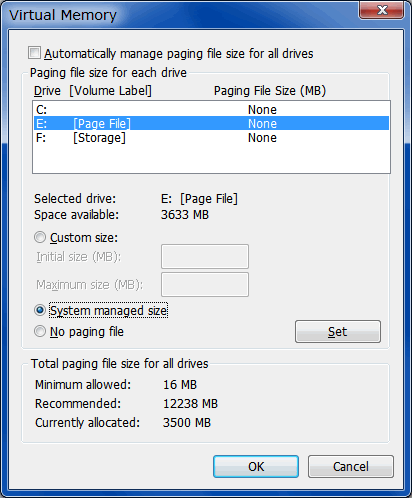How to Get Advertised Ssd Nvme Read Write Speed
As an Amazon Associate I earn from qualifying purchases (affiliate links).

How to Optimize SSD for Faster Performance (Windows Tweaks)
Capacities of Solid Country Drives are steadily rising, while prices continue to fall. It's becoming extremely mutual to notice mid-range notebooks and desktop PCs with a decently sized (500GB+) SSD. All these new Solid Land Drives replacing traditional platter based HDDs for everyday employ volition need to be optimized, and near users are probably not aware of the differences in setup procedures and regular maintenance for SSDs vs HDDs.

A SSD by itself is very fast, but 1 that has been properly installed and configured will provide even greater speeds, increased reliability, and a longer lifespan. Windows 7, eight and 10 do an ok chore with their default SSD configurations, merely the tips and tweaks shared hither volition enable you to have full advantage of your new SSD installed in a Windows PC.
Disclaimer: This guide deals with making changes to the Windows Registry and other advanced system settings. PCHardwareHelp.com will not be responsible should you lot make any mistakes that cause harm to your Windows installation. Continue with caution and at your ain risk.
one. IDE vs AHCI Mode
Before installing Windows on a new SSD, y'all should get-go enter your motherboard'due south BIOS and enable AHCI (Advanced Host Controller Interface) mode instead of IDE in the SATA controller's configuration expanse if given the option (this would too exist a good time to update the BIOS firmware before installing Windows). Older systems may not have this option, just most newer motherboards will support AHCI. If your BIOS is already setup for AHCI don't touch a thing. IDE is typically the default option used when installing a normal HDD, and so if making the switch this will need to be changed. Once AHCI is selected it will enable hot swapping and native command queuing, which should give you a nice performance boost of 10-fifteen percentage over IDE mode. AHCI is supported in Vista and all Windows operating systems released later information technology.

Reminder: This stride must be completed before installing the Os. The PC will neglect to boot if you install in IDE mode and later try to modify it to AHCI, forcing you to format and reinstall windows in the correct manner.
It is possible to enable AHCI fashion on a current Windows 7 install in IDE manner if you lot don't wish to do a fresh install. This will require making some changes via Regedit and then entering your BIOS subsequently rebooting and switching to ACHI manner. Here's how to practise information technology:
- Open the Run carte du jour by hit the Windows key + R.
- Type in Regedit and hit enter to enter the registry navigator.
- Kickoff, navigate to HKEY_LOCAL_MACHINE\System\CurrentControlSet\services\iaStorV and modify the REG_DWORD Start from iii to 0 by right-clicking it and hitting modify.
- Now navigate to HKEY_LOCAL_MACHINE\Organization\CurrentControlSet\services\msahci and follow the same procedure of modifying the Start value to 0.
- After those ii changes are made to Regedit you must reboot your PC, enter the BIOS, and switch from IDE to AHCI mode. Now you're done!

2. Confirm TRIM is Running
The purpose of TRIM is to allow the Operating System to communicate to the SSD that a block of data is no longer needed or beingness used by the file system (garbage collection). If TRIM is not functioning you lot may notice a drop in performance. TRIM is supported in Windows vii and 8, simply not Vista. Follow these steps to verify that TRIM is installed and working properly:
- Search for cmd in Windows search.
- Once the Cmd programme is displayed in the search right click information technology and select Run as Administrator.
- Now type in this line without quotes and hitting Enter: "fsutil behavior query DisableDeleteNotify"

If TRIM is running information technology volition return DisableDeleteNotify=0, or DisableDeleteNotify=1 if TRIM is non functioning.
3. Avoid and Disable Deejay Defragmenter
 Disk Defragment should never be run on a SSD. Fortunately, the default setting for Windows 7 and eight (merely not Vista) for a SSD is to disable the disk defragmentation scheduling utility because it is but not needed for a Solid State Drive. All running the disk defragmenter on a SSD will achieve is adding additonal article of clothing and tear by increasing number of writes, thus decreasing the expected lifespan of your SSD.
Disk Defragment should never be run on a SSD. Fortunately, the default setting for Windows 7 and eight (merely not Vista) for a SSD is to disable the disk defragmentation scheduling utility because it is but not needed for a Solid State Drive. All running the disk defragmenter on a SSD will achieve is adding additonal article of clothing and tear by increasing number of writes, thus decreasing the expected lifespan of your SSD.
If y'all are running Vista and need to disable the disk defragmentation utility or just want to verify it isn't running in Windows 7 or 8, follow these steps:
- Type dfrgui into Windows Search and open Disk Defragmenter.
- Select your SSD from the list of devices and hit Configure Schedule.
- Uncheck Run on a schedule if checked to disable deejay defragmenter from running automatically.
4. Disable Indexing Service/Windows Search
The indexing service in Windows is implemented to make the search function perform faster by storing an index of file locations. The service was designed to improve search performance when using a mechanical HDD, only the quick response times of SSDs make this service obsolete and unnecessary. Indexing is also another service that makes multiple small writes to a storage drive any time a file is created, changed, or removed. It's wise to disable this service if you wish to avoid unnecessary wear to the SSD.
- Click Start and open Computer.
- Notice the SSD you would similar to disable indexing service on, correct-click it and cull Backdrop.
- Uncheck the box next to Allow files on this bulldoze to have contents indexed in add-on to file properties.
v. Enable Write Caching for SSDs
 Write caching can improve performance of both SSDs and HDDs. It'southward commonly enabled past default, only if not here's how to turn it on:
Write caching can improve performance of both SSDs and HDDs. It'southward commonly enabled past default, only if not here's how to turn it on:
- Correct-click Reckoner and select Properties.
- Click Device director on the left and then expand Disk drives.
- Find your SSD, right-click it, hitting Properties and become to the Policies tab.
- Brand certain Enable write caching on the device is checked and hit Ok.
Write-cache Buffer Flushing
Double check to make sure the box next to "Turn off Windows write-cache buffer flushing on the device" is not checked. Having this option selected will put your filesystem and any important data stored on the drive at adventure in the event of any external interruptions such as power failures. With that said, if you are not concerned about data integrity and just want the fastest SSD functioning possible, enabling this option may provide the speed boost you crave. I say may because this seems to vary from drive to drive and system to system (Intel recommends to not disabling write-cache buffer flushing on their drives). Benchmark your SSD with it enabled and disabled to determine if information technology provides any do good.
six. Update Drivers and Firmware for Your SSD
The software that comes bundled with most PC hardware (SSDs included) is usually outdated, so get into the addiction of checking the manufacturers website to download the newest drivers and firmware updates. This applies to every component in the PC, specially your motherboards chipset drivers as they tin take a huge impact on SSD speed and reliability.
7. Optimize or Disable Page File for SSDs
 Yet another feature that makes numerous writes to a SSD that could potentially lessen lifespan. In that location is a lot of argue about whether folio file should be used or not. My personal recommendation is to go along information technology enabled as a page file is required for the organisation to create memory and kernel dumps. Some other solution is to motility your page file to a seperate drive if you have one bachelor.
Yet another feature that makes numerous writes to a SSD that could potentially lessen lifespan. In that location is a lot of argue about whether folio file should be used or not. My personal recommendation is to go along information technology enabled as a page file is required for the organisation to create memory and kernel dumps. Some other solution is to motility your page file to a seperate drive if you have one bachelor.
To move page file onto a secondary drive:
- Correct-click Computer and select Properties.
- Click Advanced system settings in the left pane.
- Select the Advanced tab and under the Operation section, click Settings...
- Choose the Avant-garde tab and click the Change... button under Virtual Retentiveness.
- Uncheck the box next to Automatically Manage paging file size for all drives.
- Select the second drive where the page file will exist stored, cull either a fixed Custom size or System managed size, click Ready and so Ok.
To disable the page file completely just follow the above 1-v steps, select No paging file, click Gear up and so Ok.
8. Plough Off Arrangement Restore
This is a tweak I presume many SSD users will choose not follow, merely you lot should. When irreversible problems occur System Restore can be a nice fallback, but if you have no important data that needs to be protected on your C: drive (y'all should be backing up externally anyway) I advise you disable Organization Restore. One time System Restore has been turned off information technology will complimentary up a few GB's of space, reduce writes to your SSD, and allow yous to avoid conflicts with TRIM that tin can lead to severe drops in SSD operation.
To plough of Organization Restore y'all must:
- Correct-click on Computer and choose Properties.
- Navigate to System Protection in the left pane.
- Printing the Configure button.
- Select the bubble adjacent to Plough off organisation protection and click OK.
9. Use High Performance Power Settings
The power saving options in Windows can exist useful for a notebook PC when you demand that extra hr of battery life. In a desktop environment the high performance power plan should be used then none of your components are downclocked to lower speeds in a effort to lower ability consumption. You tin besides enable garbage collection to run on your SSD when idle in the advanced power management settings by telling your drive to never plough itself off and and disabling Sleep.
- Go to Command Panel and click Power Options.
- Select the High performance program. If loftier performance isn't viewable, click Bear witness additional plans to aggrandize the unabridged list.
- Click Change plan settings next to the Loftier performance program.
- Now click Change avant-garde power settings
- Navigate to the Hard disk option and change Plow off hd afterwards to Never (0 minutes).
- Navigate to the Sleep pick and modify Sleep afterward to Never (0 minutes) and click OK.

Disable Hibernation
This one will exist a personal preference. If you really need hibernation to role for the power saving or other reasons plain just exit it exist, simply disabling it will free upwards a adept clamper of precious storage capacity on your SSD, equally hibernation uses approximately the same amount of space as the amount of RAM installed in the PC. If you have 16GB of RAM that is no small amount of space on near SSDs.
To disable Hibernate:
- Search for cmd and right-click the control prompt icon to select Run as administrator.
- Blazon powercfg -h off and press Enter.
Decision
You may not cull to endeavour all of these suggested SSD tweaks and optimizations, but information technology'southward important for you to, at the very least, install Windows onto your SSD in AHCI mode, verify TRIM is working properly, and disable scheduling of disk defragmentation. These steps volition insure your SSD runs more efficiently with better functioning and hopefully continues operating into the hereafter with a longer lifespan.
mayfieldwasonever.blogspot.com
Source: https://www.pchardwarehelp.com/guides/optimize-ssd-windows.php
0 Response to "How to Get Advertised Ssd Nvme Read Write Speed"
Post a Comment